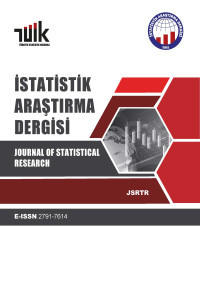Türkiye'deki Nüfus Artışı ve Nüfus Projeksiyonlarının Ekonometrik Analizi
Türkiye'de 1927 yılından bu yana resmi nüfus sayımını yapan Türkiye İstatistik Kurumu (TÜİK), 1927 yılının birinci nüfus sayımı yılından başlayarak 2006 yılına kadar tüm yıllar için geriye dönük yıl ortası nüfus tahminleri, 2007-2017 yıllarına ait adrese dayalı nüfus sayımı sonuçları ve yıl ortası tahminleri ile 2018-2080 dönemine ilişkin nüfus projeksiyonlarını yayınlamıştır. Tahminlerin ana senaryosuna göre, nüfus 2069'da 107,7 milyona ulaşacak ve bu noktadan sonra 2080'de 107,1 milyona inecektir. TÜİK nüfus projeksiyonları yöntemi çalışması, kurumun uzun vadeli deneyim ve verilerine, demografi disiplini ilkelerine ve derlenen uluslararası verilere dayanan boyutları kapsamaktadır. Bu ekonometrik çalışmadaki amacım, çalışma sırasında geliştirdiğim beş ve altı parametreli Gompertz nüfus artış modeli ve ayrıca artıklar için sinüzoidal fonksiyon uygulamaları ile ana senaryo projeksiyonlarının ve geçmiş sayımların sonuçlarının temsilini araştırmaktır. İlaveten Verhulst beş ve altı parametre fonksiyonları için de uygulama yaptım. Tüm fonksiyonlarla yapılan pozitif istatistiksel ve doğrusallık test sonuçlarına ulaştım. Ekonometrik çalışma sonuçları, İstatistik Kurumu'nun ana senaryo projeksiyonlarının geçerli ve gerçekçi olduğunu doğrulamaktadır.
Anahtar Kelimeler:
Doğrusal Olmayan Fonksiyonlar, Gompertz Fonksiyonu, SAS MODEL Yöntemi, SAS NLIN Yöntemi, Türkiye Nüfus Çalışması, Verhulst Fonksiyonu
Econometric Analysis of Population Increase and Population Projections in Turkey
Turkish Statistical Institute (TurkStat), which has been carrying out the official censuses in Turkey since 1927, published backward mid-year population estimates for all years from the first census year of 1927 to 2006, address-based census results and mid-year estimates for 2007-2017 and population projections for 2018-2080 period. According to the main scenario of the projections, population will reach 107.7 million in 2069, and from this point, it will decrease to 107.1 million in 2080. TurkStat population projections method covers the dimensions which is based on the institution’s long term experience and data, the principles of the discipline of demography e, and international data compiled. My aim in this econometric study is to investigate the representation of the main scenario projections and the results of past censuses with five and six parameter Gompertz population growth model which was developed during this study and also sinusoidal function applications for the residuals. In addition, I also applied Verhulst five and six parameter functions and reached positive statistical and linearity test results made with all functions. The results of the econometric study confirmed that the main scenario projections of the Statistical Institute are valid and realistic.
Keywords:
Gompertz Function, Nonlinear Functions, SAS MODEL Procedure, SAS NLIN Procedure, Turkish Population Study, Verhulst Function,
___
- Allen, R. G. D. (1956). Mathematical Economics. London: Macmillan & Co Ltd.
- Allen, R. G. D. (1969). Mathematical Analysis for Economists. London, UK: Macmillan and Co. Ltd. (Original work published 1938).
- Canpolat, S. B. & Gök, M. G. (2020). Census Methodology in Turkey: Transformation from Traditional to Register-based Administrative Data. Statistical Journal of the IAOS, 36(1), 177–185. https://doi.org /10.3233/SJI-190561
- Gebremariam, B. (2014). Is Nonlinear Regression Throwing You a Curve? New Diagnostic and Inference Tools in the NLIN Procedure (No. Paper SAS384-2014). Retrieved from https://support.sas.com/resources /papers/proceedings14/SAS384-2014.pdf
- İskender, C. (2018). Türkiye Nüfus Büyümesi ve Tahminleri: Matematiksel Büyüme Modelleri ve İstatistiksel Analiz ile Kuramsal ve Uygulamalı bir Yaklaşım. Istanbul University Econometrics and Statistics E-Journal, 14(28), 75–141. https://doi.org/10.26650/ekoist.2018.14.28.0004
- İskender, C. (2021). Mathematical Study of the Verhulst and Gompertz Growth Functions and Their Contemporary Applications. Ekoist : Journal of Econometrics and Statistics, (34). Retrieved from https://dergipark.org.tr /tr/pub/ekoist/issue/64260/876749
- Piaggio, H. T. (1920). An Elementary Treatise on Differential Equations and Their Applications (W. P. Milne, ed.). London: G. Bell and Sons, Ltd.
- Ratkowsky, D. A. (1993). Principles of Nonlinear Regression Modeling. Journal of Industrial Microbiology, 12(3–5), 195–199. https://doi.org/10.1007/BF01584190
- Richards F. J. (1959). A Flexible Growth Function for Emprical Use. Journal of Experimental Botany, 10(2), 290–300.
- Ricketts, J. H. & Head, G. A. (1999). A Five-Parameter Logistic Equation for Investigating Asymmetry of Curvature in Baroreflex Studies. American Journal of Physiology - Regulatory, Integrative and Comparative Physiology, 277(2), R441–R454. https://doi.org/https://doi.org/10.1152/ajpregu.1999.277.2.R441
- SAS Institute Inc. (2011). SAS/STAT® 9.3 User’s Guide The NLIN Procedure (Chapter). In SAS Institute Inc. 2011. SAS/STAT® 9.3 User’s Guide. Cary, NC: SAS Institute Inc. Retrieved from https://support.sas.com /documentation/onlinedoc/stat/930/whatsnew.pdf%0A
- SAS Institute Inc. (2013). SAS/STAT ® 13.1 User’s Guide The NLIN Procedure. In SAS Institute Inc. 2013. SAS/STAT® 13.1 User’s Guide. Cary, NC: SAS Institute Inc. Retrieved from https://support.sas.com /documentation/onlinedoc/stat/131/nlin.pdf
- SAS Institute Inc. (2018a). SAS/ETS® 15.1 User’s Guide The MODEL Procedure. In SAS Institute Inc. 2018. SAS/ETS® 15.1 User’s Guide. Cary, NC: SAS Institute Inc. SAS/ETS® (2018th ed.). Retrieved from https://support.sas.com/documentation/onlinedoc/ets/151/model.pdf
- SAS Institute Inc. (2018b). SAS/STAT® 15.1 User ’ s Guide The NLIN Procedure. In SAS Institute Inc. 2018. SAS/STAT® 15.1 User’s Guide. Cary, NC: SAS Institute Inc. Retrieved from https://support.sas.com /documentation/onlinedoc/stat/143/nlin.pdf
- Tenenbaum, M., & Pollard, H. (1963). Ordinary Differential Equations. New York: Dover Puplications.
- TurkStat. (2021). Population and Dempgraphy Statistics. Retrieved from https://data.tuik.gov.tr /Kategori/GetKategori?p=Population-and-Demography-109
- Verhulst, P.-F. (1838). Notice Sur La Loi Que La Population Suit Dans Son Accroissement. In A. Quetelet & J. G. Garnier (Eds.), Correspondance Mathématique et Physique (Vol. 4, pp. 113–121). Retrieved from https://archive.org/details/correspondancem02belggoog/page/n122/mode/2up
- ISSN: 1303-6319
- Başlangıç: 2002
- Yayıncı: TÜİK
Sayıdaki Diğer Makaleler
Türkiye'de Hanehalkı Yoksulluğunu Etkileyen Faktörlerin Belirlenmesi
Kantil Regresyon Modellerinde Uyum İyiliği Ölçüleri ve Model Seçimi
Türkiye'deki Nüfus Artışı ve Nüfus Projeksiyonlarının Ekonometrik Analizi
Türkiye’de Toplumsal Cinsiyetin Çok Boyutlu Ölçekleme ile İncelenmesi
